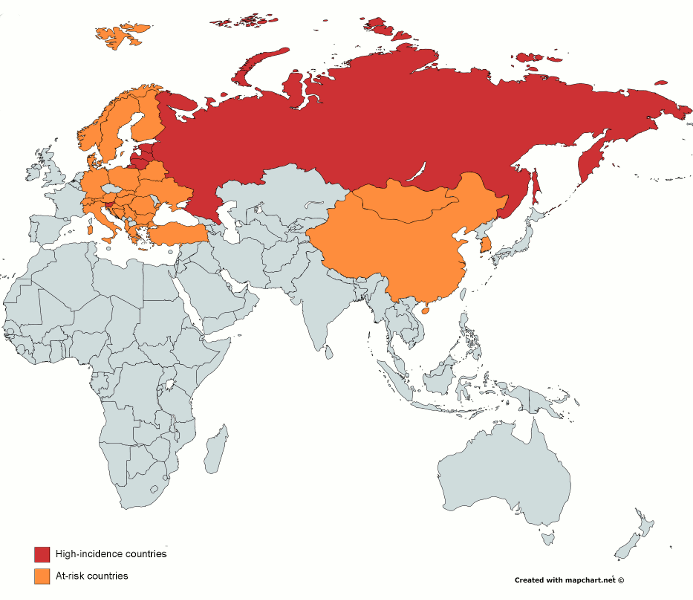Tick-borne encephalitis (TBE) occurs throughout the northern hemisphere, and mirrors the geographical distribution of the usual vector, Ixodes species ticks.[2]Barlow G, Irving WL, Moss PJ. Infectious diseases and tropical medicine. In: Kumar P, Clark M, eds. Kumar & Clark’s clinical medicine. 9th ed. London: Elsevier; 2016. Most cases occur in areas below an altitude of 750 metres.[3]Centers for Disease Control and Prevention. CDC Yellow Book 2024: health information for international travel. Section 5: travel-associated infections & diseases - tick-borne encephalitis. May 2023 [internet publication].
https://wwwnc.cdc.gov/travel/yellowbook/2024/infections-diseases/tick-borne-encephalitis
In Europe, tick activity starts in spring when the temperature approaches 6ºC and usually persists until November when the temperature falls.[8]Lindquist L, Vapalahti O. Tick-borne encephalitis. Lancet. 2008 May 31;371(9627):1861-71.
http://www.ncbi.nlm.nih.gov/pubmed/18514730?tool=bestpractice.com
In TBE-endemic countries (i.e., focal areas of Europe and Asia), the annual incidence of the disease ranges from <1 to >20 cases per year, per 100,000 population.[1]Hawker J, Begg N, Reintjes R, et al. Communicable disease control and health protection handbook. 4th ed. Oxford: Wiley Blackwell; 2019 In Europe, 3817 cases were reported in 2020 (0.9 cases per 100,000 people, an increase from 0.6 per 100,000 people in 2016). Throughout the European Union, TBE was most common in adults aged 45 to 64 years, with a 1.5:1 male to female ratio.[9]European Centre for Disease Prevention and Control. Tick-borne encephalitis: annual epidemiological report for 2020. Oct 2022 [internet publication].
https://www.ecdc.europa.eu/en/publications-data/tick-borne-encephalitis-annual-epidemiological-report-2020
Russia has the largest number of reported cases.[3]Centers for Disease Control and Prevention. CDC Yellow Book 2024: health information for international travel. Section 5: travel-associated infections & diseases - tick-borne encephalitis. May 2023 [internet publication].
https://wwwnc.cdc.gov/travel/yellowbook/2024/infections-diseases/tick-borne-encephalitis
In the UK, TBE virus-infected ticks have been identified in Thetford Forest (in the East of England), the Hampshire and Dorset border, the New Forest, and the North Yorkshire Moors. Two probable and two confirmed cases of TBE have been reported in the UK since 2019. However, the risk to the general public remains very low according to a 2023 risk assessment report. The risk to high-risk groups (e.g., those living, working, or visiting affected areas, as determined by duration of time spent outside), also remains low.[10]UK Health Security Agency. HAIRS risk assessment: tick-borne encephalitis. Apr 2023 [internet publication].
https://www.gov.uk/government/publications/hairs-risk-assessment-tick-borne-encephalitis/hairs-risk-assessment-tick-borne-encephalitis
Some non-endemic countries (e.g., Australia) have reported imported cases.[11]Chaudhuri A, Růžek D. First documented case of imported tick-borne encephalitis in Australia. Intern Med J. 2013 Jan;43(1):93-6.
https://onlinelibrary.wiley.com/wol1/doi/10.1111/imj.12017/full
http://www.ncbi.nlm.nih.gov/pubmed/23324091?tool=bestpractice.com
[12]Pontali E, Bobbio N, Cassola G. Tick-borne encephalitis (TBE) during a "grand-tour" of Europe clinically manifesting in a TBE-free region. J Travel Med. 2010 Mar-Apr;17(2):143-5.
https://jtm.oxfordjournals.org/content/17/2/143.long
http://www.ncbi.nlm.nih.gov/pubmed/20412185?tool=bestpractice.com
In US civilian travellers, 11 cases were reported between 2000 and 2020; however, additional cases may have occurred as TBE is not a notifiable condition in the US.[3]Centers for Disease Control and Prevention. CDC Yellow Book 2024: health information for international travel. Section 5: travel-associated infections & diseases - tick-borne encephalitis. May 2023 [internet publication].
https://wwwnc.cdc.gov/travel/yellowbook/2024/infections-diseases/tick-borne-encephalitis
The geographical distribution of TBE viruses is as follows:[13]Hills SL, Fischer M. Arboviral encephalitides. In: Heymann DL, ed. Control of communicable diseases manual. 20th ed. Washington, DC: American Public Health Association; 2015.
Western/European subtype - endemic in parts of Scandinavia, and in Central and Eastern Europe down to the Adriatic region
(Ural-) Siberian subtype - endemic from Europe across the Ural Mountains to the Pacific Ocean, Korea
Far Eastern subtype - endemic in Russia, China, northern Japan
Louping ill subtype - endemic in the UK, Ireland, Norway.
Geographical distribution maps are available from the European Centre for Disease Prevention and Control (ECDC) and US Centers for Disease Control and Prevention (CDC):
Powassan virus (a related tick-borne flavivirus that can present with encephalitis) is endemic in Canada, Russia, and the New England states of the United States.[4]Bloch KC, Glaser CA, Tunkel AR. Encephalitis and myelitis. In: Cohen J, Powderly WG, Opal SM, eds. Infectious diseases. 4th ed. London: Mosby Elsevier; 2016.
[Figure caption and citation for the preceding image starts]: Geographical distribution of clinical cases of TBE in Europe and AsiaCreated by BMJ Evidence Centre; adapted from: World Health Organization. International travel and health: tick-borne encephalitis. 2016 [Citation ends].
